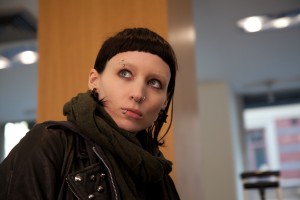‘The Girl with the Dragon Tattoo’ Film Adaptation Strays from Stieg Larsson’s Novel to Its Advantage
It is rarely said that a film adaptation is better than the book, but in the case of David Fincher’s latest film The Girl with the Dragon Tattoo, based on Stieg Larsson’s award-winning crime novel of the same name, this is truly the case. Unnecessary details are cut for an exciting and successful version for the big screen.
Journalist Mikael Bloomkvist (Daniel Craig), after being accused of libel, is recruited to write the memoirs of the ailing millionaire heir, Henrik Vanger (Christopher Plummer), and solve the 40-year-old mystery of Vanger’s missing niece. Bloomkvist soon learns that he is on the trail of a serial murderer, and with the help of the eccentric technological genius, Lisbeth Salander (Rooney Mara); he gets to work on cracking the case, threatening his and Salander’s lives as they get closer to the truth.
While the beginning of Larsson’s novel is bogged down with boring description of Bloomkvist’s legal rigmarole, the movie eliminates the intricacies. This may be a tad confusing for those who haven’t read the book, but it is done to the film’s advantage and keeps the story moving quickly.
Though coming close to two and a half hours of running time, the film still manages to exert an abundant dose of adrenaline. Fincher focused on the action of the story to create a captivating experience on film. Had he included all of Larsson’s detail, two and a half hours or more would have been painfully dull.
Craig, as Bloomkvist, is a little less homely than Larsson suggests in print. With his stern, serious face, it is hard to see Bloomkvist as a father, and suggestion of his having been a family man is limited. He is more quiet than passionate in film, and his sexual relationship with Cecilia Vanger, another niece of Henrik’s, is not included, but also not necessary.
In fact, Craig’s portrayal of Bloomkvist can be seen as a bit cold and flat. His developing relationship with Salander does not translate as warm and caring as it is vividly illustrated in the book; it is more confusing, but in retrospect, may serve to more acutely define Salander’s dynamic character. The only time viewers become sympathetic toward Bloomkvist is when he is in the paws of the murderer, but no one wants to see an innocent party killed.
Other characters are distant and somewhat uninteresting, though also not particularly important to the plot. As in the novel, the Vanger family is very large and perplexing—many characters mirror each other in personality and quirks. We don’t get to know Vanger as well as in the novel, and thus viewers may be slightly less attached to the mystery. The draw of the movie lies in the character of Salander and her unpredictability.
Mara, in her role as Salander, is a jumble of contradictions, which somehow make her the most sincere character in the story. Often withdrawn, but in a dramatically awe-inspiring way, she rarely makes eye contact during conversation, but when she does, the stare is unwavering. Tiny and hunched like a scared animal, she walks with determination, and while she is of few words, she means what she says. Salander trusts few, but is loyal to those who gain her trust, like Bloomkvist eventually does.
The differences in the film portrayal of Salander to the ones in the novel, serve the film greatly. Larsson’s description of Salander as a brooding, childish mall-goth makes her hard to take seriously. However, the juxtapositions that create this complex character are more apparent in film. Twenty-three-year-old Salander is a victim many times over, but she never goes unavenged. She is strong and capable, yet deeply troubled. As Salander, Mara is strange, yet intriguingly beautiful, with buzzed, jet black hair contrasting her barely-there blonde brows and porcelain skin. And though she looks exceptionally thin, almost anorexic (as Salander is described to be in the book) viewers should not underestimate her ability to stop rapists, murderers, and every day human beings in their tracks.
“She’s different…in every way,” her boss, played by Goran Visnjic, finds it necessary to warn others about Salander before introduction. Mara’s portrayal of her is what keeps the movie going. It is impossible to guess what Salander is going to do next. Will she seek revenge on her abusive financial adviser? Will she sleep with another woman?
While Fincher’s conclusion of the adaptation strays from the novel’s ending, it more neatly ties loose ends and answers questions more thoroughly than Larsson does. Similar to the novel, Salander’s revenge on Wennerström (Ulf Friberg), Bloomkvist’s nemesis against whom he is accused of committing libel, seems to be an afterthought used to extend the plot.
The plot of both the novel and the film version of The Girl with the Dragon Tattoo is chock full of cheap thrills, but cheap thrills are thrills nonetheless. Perhaps all of the murder, rape, car crashes, sex, and unbelievable spy technology are what makes Larsson’s trilogy so popular. Either way, the story translates to film so smoothly that Larsson could have skipped the novel and gone right to the big screen.
Rating: 3 out of 4 stars


